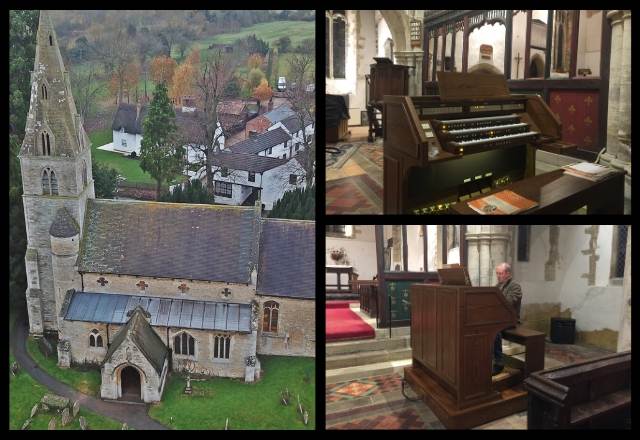I have chosen this customer installation to write up in some detail as there is an interesting story to tell that involves a lot of the issues faced by our country churches in general and specifically with organ improvements.
All Hallows Church is unusual in the following respects:-
- The speed with which the formal processes were completed.
- The conditions on removal of the pipe organ.
- The size of digital organ they were allowed to acquire.
- Building maintenance works that followed on from removal of the pipe organ.
A pipe organ beyond economic repair
Hargrave is a typical small rural village community with a church seating of about 120, maintained in good condition and with remarkably warm heating as we found during our installation work in late November. The pipe organ there was never of great quality but it served its community well for probably well over half a century when recently age was taking its toll and repairs were greatly needed.
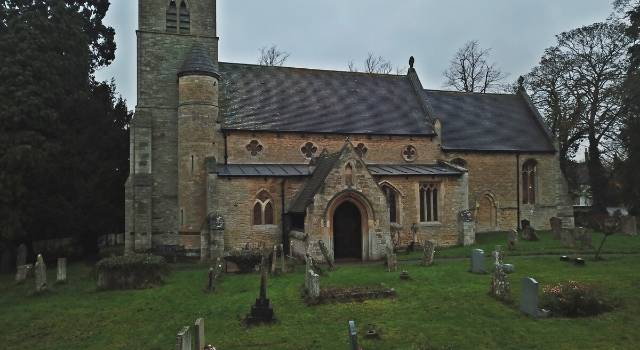
As well as the usual mechanical issues tracker action organs of this age suffer from, an inspection by the local organ builder pretty much condemned the instrument as beyond any economic repair as the organ frame was riddled with woodworm and near fatal collapse.
This was the trigger for the local organist and it has to be said the champion of this project to think outside the usual box and decide what might be done to combine a new instrument with a wider functionality of the church:
- The smaller footprint from a digital organ would also release floor areas from a hitherto “organ occupied” corner of the south aisle.
- A lower height from a digital instrument also would allow much needed sunlight in through two windows (one lovely centuries old stained glass) into the dingy corner where the previous organ fully obscured two windows
- All Hallows enjoys a short but lively summer music festival and a more comprehensive instrument would allow the scope of that to be increased both chorally and also offer the opportunity for organ recitals.
(Experience All Hallows Church with our 3D model below)
Embarking on the process of selecting a new organ
And so it was in March of 2019 All Hallows embarked upon the process of selecting a new instrument, seeking DAC faculty approval, lining up contractors for the minor building repairs and fund raising. Now in my experience for most churches this would be a 2 year programme but All Hallows got it all done in just 8 months.
First step of course is the faculty application. Most Diocesan Advisory Committees (DAC’s) meet just quarterly so slipping a week in the process can actually set you back 3 months. Through great liaison with the DAC secretary I rather suspect a few days were borrowed from deadlines and matters shuffled onto meeting agenda’s that strictly they may have missed. My point here is that with grace and the aligned will of all parties the application hit the very first available DAC meeting.
Concern was in my opinion rightly raised as to the size of instrument All Hallows wanted to install. 3 manuals and 50 stops is substantially bigger than any pipe instrument that would possibly ever be found in a church of this size. However the DAC were persuaded to think broadly and this instrument was accepted after submission of two more papers answering their questions. The DAC acceptance was predominantly in the context of:
- The proposed instrument was affordable – and considerably cheaper than buying a new pipe organ;
- Would hold lower running costs and a demonstrably lower whole life cost for the village church;
- A second hand pipe organ would likely not be heard and potentially reintroduce the same issues from which the existing elderly instrument suffered;
- Since the primary purpose of the instrument is to support worship and prayer to God – why select a lower capability from a traditional pipe organ when a digital instrument could better support and hence this primary purpose for having an organ in the village church.
Although the context of the music festival was not a primary motivator for the DAC, it undoubtedly had some relevance because it attracts people into the church building. However, the musical festival and its cultural enhancement of local communities was an appealing aspect to a nearby Windfarm trust, who very kindly contributed nearly one third of the cost of the instrument through a grant.
If I may offer a controversial point here just because there are 50 stops available does not mean that the organist has to use them. It is probably true that many will, but that is a matter of training. We nearly all have cars capable of speeds well over 100 mph but we don’t always drive at that speed do we? Although many may have succumbed to thrill of the occasional blast.
Permission granted for a 3 manual organ
Anyway – rather to my surprise the faculty was granted with permission for our 3 manual instrument but on the proviso that a new home was found for the small instrument that was to be removed. (Something of a challenge given its condition).
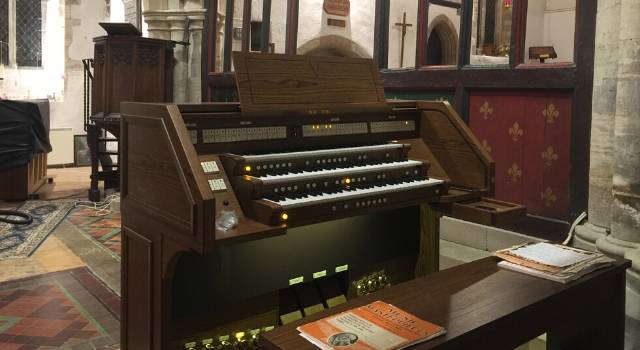
We undertook to help with that as our organ community social reach is considerable and the blog we produced very quickly found an organ builder from Germany who came over in late summer and over 2 days dismantled the instrument for rebuilding on the continent. (The other applicant for the organ was from Latin America, where the shipping cost would likely have proved insurmountable. They were disappointed to lose out to the German’s though!)
The removal also revealed that as well as near to imminent collapse, the instrument was also at risk of the floor collapsing under it. The building works scope was slightly bigger than anticipated and also now that the south east corner of the south aisle was accessible it was apparent that there was a leaking roof to deal with, too.
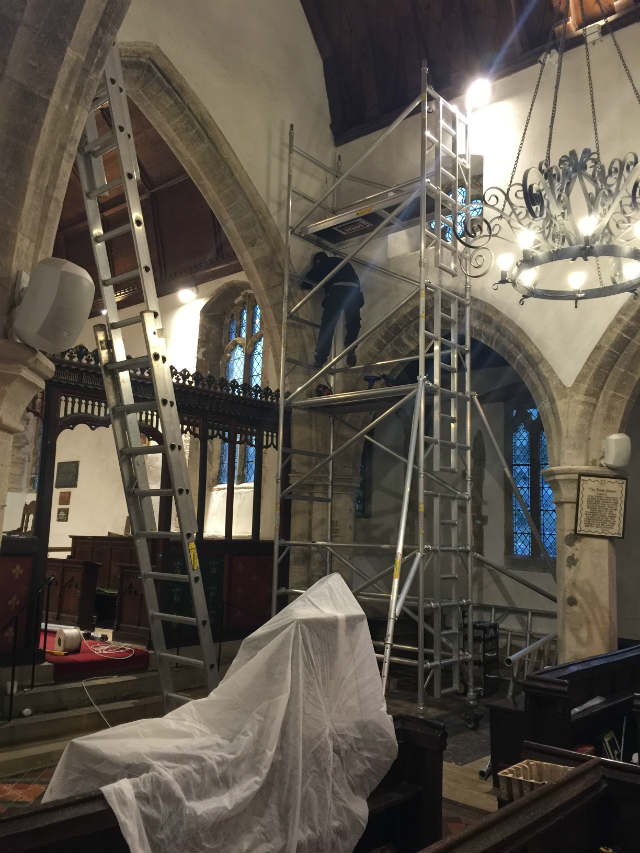
The Parish Architect (Adrian Ringrose) had been involved from the very first concept and discussion of a new organ. He valued the opportunities the proposal brought, and proved very supportive throughout, offering good advice on how to deal with the not uncommon structural issues found in the floor and damp in the wall. The new organ proposal also offers the prospect of tidying up some unnecessarily obtrusive wiring from 10-20 years ago.
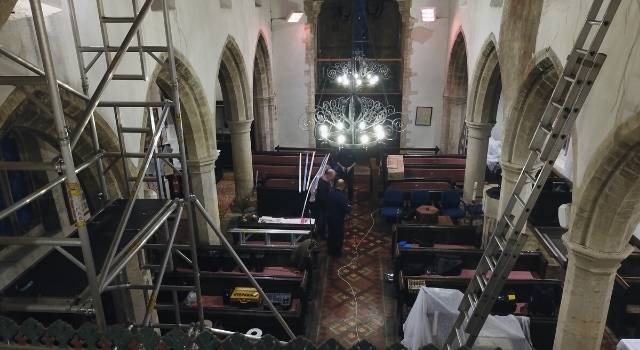
Ensuring the installation was as unobtrusive as possible
The church had procured immediately once the twin prongs of the windfarm grant was committed on one hand and the permission from the DAC secured on the other; so by now our organ was in manufacture. …. and it was only September. By only mid-October we found ourselves asked to plan an installation date: which we duly completed on November 25/26 to the joy of the organist, the priest and the parishioners!
Crucial in this small and handsome church has been ensuring that the installation was as unobtrusive as possible. On our first visit to the church, before the first DAC paper was even submitted, we had had the opportunity to meet the architect and agree potential speaker locations.
All Hallows is typical of many church constructions offering a very generous space on the north and south side wall plates behind the ashlar posts that might have been made with speakers in mind. From these invisible locations we can direct sound at the roof which reflects the sound into the nave.
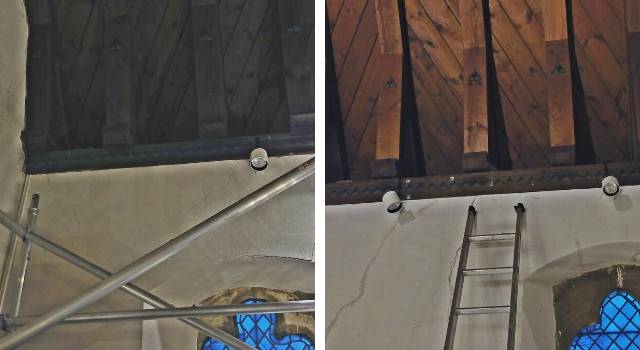
We were also keen though to create a more immediate sound source that would assist choral accompaniment and here the rood screen came to our assistance. The music festivals often have a large choir standing west of the chancel steps. With organ by their side in the south aisle speakers behind the choir would offer an ideal solution for both choir and accompanist and so we set the entire choir division to play from this location.
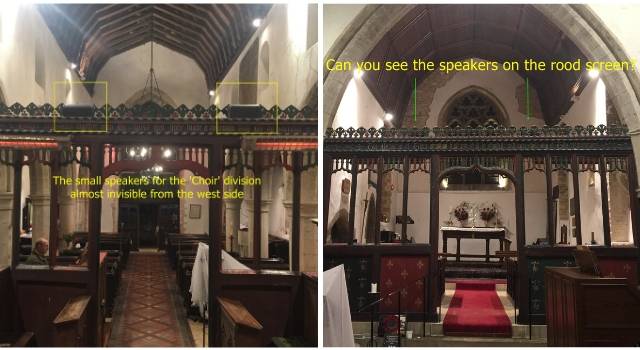
As you can see from the photographs these speakers, pointing directly to the roof, are near invisible hidden by the rood screen cornice. Only from the east side where the screen has already been ‘corrupted’ by some heaters are the speakers at all visible.
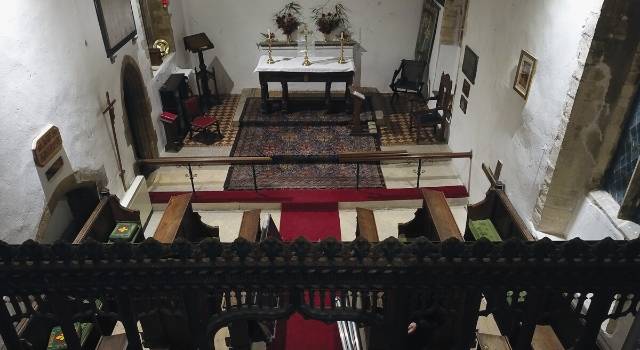
For good measure and sensitivity, the solo Tuba stop present on the choir is set up to play from the far west end nave speakers so they can never accidentally disrupt proceedings near the altar.
The final touch adding to flexibility was to place our console onto a mobile plinth so it can be moved to the centre for recitals and even to the north side aisle if for any reason that larger space proves more appropriate for whatever event is on in the building.
(Listen to two recordings of the organ below)

A successful project from start to finish
So why could this all be achieved so quickly?
- The church involved everyone from the earliest point – when it was just a concept.
- They asked open questions, what were the options and alternatives, listened critically, and were prepared to adopt and combine advice from trusted sources – architect, Viscount, DAC Secretary, priest.
- The “business case” was very clearly set out in the first paper by the church – in terms of benefits for the village in worship and outreach; in freeing up space in the church for use in services, drama, readings, “Messy Church” etc.
- The church also pointed out the ease of use of the instrument for non-organists; and the improvement in the quality of natural light which would be brought into the church.
- They demonstrated the benefits in terms of cost incurred and affordability compared to buying and installing a second hand or new pipe organ. These elements were amplified in two further swift papers to the DAC responding to their questions and answering their concerns.
- The church secured a most helpful community grant to support their “non-religious” offering by way of the music festival – giving the project a boost towards reality of funding.
- The church wrote clear papers for the DAC, and tested their content with their advisors, offering expert evidence from Viscount on costing and on likely costs avoided in order to help answer “why digital” from a commercial perspective, as well as from a performance perspective.
- The church “project managed” this work – trying to be as open as possible with everyone; keeping all parties appraised of progress, issues and minor triumphs; and they were not afraid to ask openly for help and speed in order that the organ installation would be fully available for Christmas concerts and services (their overly ambitious initial timescale of 4 months in order to be ready for the music festival was probably always a step too far!!)
Here is a very encouraging example of what can with skill, energy, hard work and willing support be achieved in a very short time within what on occasions can be seen as a slow and cumbersome planning procedure.
Hargrave is clearly a funny kind of place – whoever heard of a builder mobilising within one week, ripping out a rotten floor and then renewing the entire floor area with paving, old tiles, and weather wood in the next week, before plastering the walls and all to the satisfaction of the parish architect ? What happened to good old-fashioned teeth-sucking for Goodness Sake?!
Anyway, whoever heard of a three-manual magnificent digital organ, normally found in a cathedral, supporting the faithful worship of 2 dozen villagers in Northamptonshire? We will have a renewed outbreak of faithfulness any time at all, for very clearly “God does His work in mysterious ways, His wonders to perform. Who can fathom His purpose”.
Just needs a little bit of faith apparently… Well done to all concerned and we are rather happy with our little bit too!
I have had a passion for church organs since the tender age of 12. I own and run Viscount Organs with a close attention to the detail that musicians appreciate; and a clear understanding of the benefits of digital technology and keeping to the traditional and emotional elements of organ playing.
